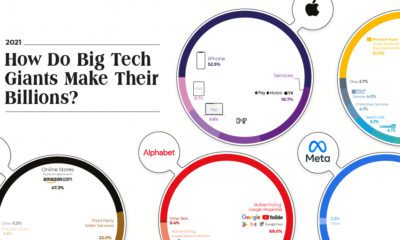Meet the 5 Companies Aiming to Bring the Web to 4.3 Billion New People
Infographic sponsored by: Datawind The internet is an essential part of our daily lives, but it is actually only used by a minority of the world’s population. 4.3 billion people across the world do not yet have access to the web. In fact, there are seven countries where more than 100 million people are not yet connected: Brazil, Nigeria, Pakistan, Bangladesh, China, India, and Indonesia. Internet penetration in developed countries such as the United States and Canada is high, averaging about 74%. However, in some of the world’s most populous regions, only about one in five people have access. In the coming decades, we will see a great revolution as billions of new people get instant access to knowledge, tools, communication, and opportunities for the first time. A study by Deloitte concludes that bringing internet access to developing countries could boost productivity worldwide by 25%, generate $2.2 trillion in GDP, create 140 million new jobs, and lift 160 million people out of poverty.
The Challenge
With many of the world’s brightest minds and entrepreneurs not yet connected to the web, it remains to be seen what new world-shaping technologies and companies will be born. However, connecting 4.3 billion people to the grid is no easy feat. Many people with no internet access live in remote areas without infrastructure or even reliable water or power. Solving these issues creates one of the largest and most challenging business opportunities the world has seen. To succeed, companies must be bold, while thinking bigger and outside of the box. Here are the companies and technologies that will further connect our world:
Big Tech
In 2014, Facebook made $4.8 billion from online ad revenue and Google made $19.1 billion. Together, that comprises 50% of all online ad revenues. If the worldwide audience for their services grows, that means a much bigger target audience for their services. As a result, both companies have been making big investments to build their networks. Google is aiming to cover the sky with floating celltowers and solar-powered drones. Project Loon, officially launched as a Google project in 2013, aims to send thousands of high-flying hot air balloons 10-20km into the stratosphere to broadcast internet to the ground over remote areas. The balloons use algorithms to read wind currents and navigate the globe, all while beaming down an internet signal. Google has broken its own records for flight duration, having a balloon that lasted 187 days in the air, circumnavigating the globe nine times and passing over more than a dozen countries on four continents along the way. Google also outbid Facebook for Titan Aerospace in 2014 for $60 million. Titan builds the world’s biggest solar powered drones. These can also broadcast internet to the ground, and are described by Google as “exactly where Project Loon was two years ago in development.” Facebook is also experimenting with satellites and drones. However, the bulk of its operations to expand the internet’s reach are through its newly formed Internet.org initiative founded in 2013. Partnering with telecoms and mobile operators like Microsoft and Samsung, Internet.org has launched apps in Zambia, Tanzania, Kenya, Colombia, Ghana, and India. Internet.org provides free access to basic internet services since it is the cost of data is one of the biggest challenges for people to absorb in developing countries. However, Facebook has been criticized for Internet.org because of the practice of zero-rating. Making some services free while having others cost money is at the heart of the debate on net neutrality.
Innovative Technology
Aside from Big Tech, there are other companies taking big steps to bringing the internet to the rest of the planet. While most of the developed world accesses internet through broadband, the cost of building the infrastructure for such networks make it a less feasible endeavour for most remote regions. That is why 90% of the world does not have fixed broadband access. Even if it existed, the cost of broadband is very expensive for people in developing countries, costing 27% of monthly gross income on average. However, Datawind has found another way to tackle the problem. Datawind has developed proprietary technology to reduce the amount of data being transmitted over cellular networks by approximately 20X on average. This allows them to provide internet access to the 93% of the world that does have mobile access mostly through 2G coverage. By turning 1MB of data into 0.05MB and pairing this service with building some of the world’s cheapest tablets and smartphones, Datawind is able to bring internet browsing costs to as low as $0.70 per month. O3b Networks, backed by Google and HSBC, is solving the traditional problem with satellite networks: latency. The company has a growing constellation of satellites that orbit the Earth at 8,000km, about 4X closer than traditional geosynchronous satellites. The resulting signal provides internet speeds that rival fiberoptic networks. BRCK, designed an prototyped in Kenya, is a rugged and portable hotspot that can broadcast WIFI or a cell signal via multiple networks. BRCK has its own power source and can be recharged via solar power. The battery lasts for eight hours in full power mode in the case of blackouts, a common problem in Africa and the developing world.
Conclusion
The internet impacts nearly every aspect of modern society and serves as a powerful economic stimulator. The opportunity to connect 4.3 billion people to the internet is not only a business opportunity, but one that will improve everyone’s standard of living.
on But fast forward to the end of last week, and SVB was shuttered by regulators after a panic-induced bank run. So, how exactly did this happen? We dig in below.
Road to a Bank Run
SVB and its customers generally thrived during the low interest rate era, but as rates rose, SVB found itself more exposed to risk than a typical bank. Even so, at the end of 2022, the bank’s balance sheet showed no cause for alarm.
As well, the bank was viewed positively in a number of places. Most Wall Street analyst ratings were overwhelmingly positive on the bank’s stock, and Forbes had just added the bank to its Financial All-Stars list. Outward signs of trouble emerged on Wednesday, March 8th, when SVB surprised investors with news that the bank needed to raise more than $2 billion to shore up its balance sheet. The reaction from prominent venture capitalists was not positive, with Coatue Management, Union Square Ventures, and Peter Thiel’s Founders Fund moving to limit exposure to the 40-year-old bank. The influence of these firms is believed to have added fuel to the fire, and a bank run ensued. Also influencing decision making was the fact that SVB had the highest percentage of uninsured domestic deposits of all big banks. These totaled nearly $152 billion, or about 97% of all deposits. By the end of the day, customers had tried to withdraw $42 billion in deposits.
What Triggered the SVB Collapse?
While the collapse of SVB took place over the course of 44 hours, its roots trace back to the early pandemic years. In 2021, U.S. venture capital-backed companies raised a record $330 billion—double the amount seen in 2020. At the time, interest rates were at rock-bottom levels to help buoy the economy. Matt Levine sums up the situation well: “When interest rates are low everywhere, a dollar in 20 years is about as good as a dollar today, so a startup whose business model is “we will lose money for a decade building artificial intelligence, and then rake in lots of money in the far future” sounds pretty good. When interest rates are higher, a dollar today is better than a dollar tomorrow, so investors want cash flows. When interest rates were low for a long time, and suddenly become high, all the money that was rushing to your customers is suddenly cut off.” Source: Pitchbook Why is this important? During this time, SVB received billions of dollars from these venture-backed clients. In one year alone, their deposits increased 100%. They took these funds and invested them in longer-term bonds. As a result, this created a dangerous trap as the company expected rates would remain low. During this time, SVB invested in bonds at the top of the market. As interest rates rose higher and bond prices declined, SVB started taking major losses on their long-term bond holdings.
Losses Fueling a Liquidity Crunch
When SVB reported its fourth quarter results in early 2023, Moody’s Investor Service, a credit rating agency took notice. In early March, it said that SVB was at high risk for a downgrade due to its significant unrealized losses. In response, SVB looked to sell $2 billion of its investments at a loss to help boost liquidity for its struggling balance sheet. Soon, more hedge funds and venture investors realized SVB could be on thin ice. Depositors withdrew funds in droves, spurring a liquidity squeeze and prompting California regulators and the FDIC to step in and shut down the bank.
What Happens Now?
While much of SVB’s activity was focused on the tech sector, the bank’s shocking collapse has rattled a financial sector that is already on edge.
The four biggest U.S. banks lost a combined $52 billion the day before the SVB collapse. On Friday, other banking stocks saw double-digit drops, including Signature Bank (-23%), First Republic (-15%), and Silvergate Capital (-11%).
Source: Morningstar Direct. *Represents March 9 data, trading halted on March 10.
When the dust settles, it’s hard to predict the ripple effects that will emerge from this dramatic event. For investors, the Secretary of the Treasury Janet Yellen announced confidence in the banking system remaining resilient, noting that regulators have the proper tools in response to the issue.
But others have seen trouble brewing as far back as 2020 (or earlier) when commercial banking assets were skyrocketing and banks were buying bonds when rates were low.














